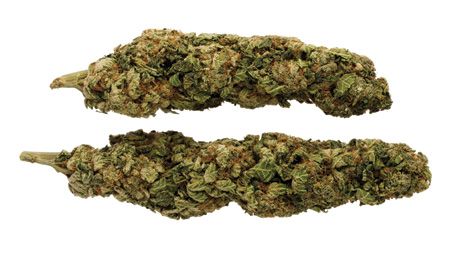The lowdown on cannabis in veterinary medicine
Fresh from the 2016 Nestl Purina Companion Animal Nutrition Summit, a look at what we know about this plant's powers in people and pets.

(Getty Images)Whether it has been awhile since you studied marijuana toxicosis in veterinary school or just saw a case of it earlier this week, the dialogue about this substance is evolving-from “illegal and toxic” to potentially beneficial for a variety of medical conditions.
Susan G. Wynn, DVM, CVA, CVCH, AHG, of BluePearl Georgia Veterinary Specialists' Nutrition and Integrative Medicine Department, discussed this controversial therapeutic intervention in her presentation about functional foods at the 2016 Nestlé Purina Companion Animal Nutrition Summit. (See part 1 of this presentation featuring golden paste, bone broth and medical mushrooms here).
Yes, it is true that a 2012 study reported a fourfold increase in the number of dogs treated for marijuana intoxication between 2005 and 2010, following the legalization of medical marijuana in Colorado.1 So brushing up on your treatment skills would be a good idea.
But how do you handle a client whose dog has been diagnosed with cancer that asks if Fido would benefit from marijuana? Here's what you need to know about cannabis and its potential medical uses.
The basics
Cannabis and humans have been acquainted with each other for a long time. Dr. Wynn imparts that, “Findings in archeological sites suggest that cannabis was in use-even cultivated-for 10,000 years.” Hemp and marijuana are two different subspecies of Cannabis sativa L. and contain more than 480 unique compounds, 85 of which are cannabinoids. The two primary cannabinoid compounds are cannabidiol (CBD) and delta-9-tetrahydrocannabinol (THC). Hemp contains primarily CBD, which is not psychoactive and has antianxiety, antipsychotic, antispasmodic and antibacterial properties. Marijuana contains higher levels of THC, which is psychoactive and has euphoretic, analgesic, anti-inflammatory, antiemetic, antioxidant, antipruritic and cholagogic properties.
How do cannabinoids cause an effect on us and our pets? The endocannabinoid system of vertebrate animals is thought to have existed for over 500 million years, yet it was only described after THC led to the discovery of the receptor and following this, anandamide, a natural cannabinoid receptor agonist, was discovered in 1992. Dr. Wynn says that the endocannabinoid system is a complex lipid-signaling network that modulates central nervous system activity, and its effects can be summarized as “relax, eat, sleep, forget and protect.”
At least five endogenous endocannabinoids have been described. They are long-chain polyunsaturated fatty acids that affect appetite; impair cognition, time perception and short-term memory; and lead to incoordination, sleepiness and enhanced body awareness. Cannabinoid receptors of different types are located in various organs throughout the body. The naturally existing cannabinoids in the cannabis plant are mimicked in synthetic cannabinoids such as dronabinol and levonantradol that have been developed for treating specific conditions.
Into the weeds
So what can cannabis be used to treat medically? In people, cannabinoids' effects are being studied on the following conditions.
Cancer. Malignant tissues tend to express higher numbers of cannabinoid receptors than nonmalignant tissues, says Dr. Wynn, and binding those receptors can trigger cancer cell death.
Nausea and vomiting. Synthetic cannabinoids are approved for use in treating nausea and vomiting in patients receiving chemotherapy in which conventional antiemetics have not been effective.
Pain. Cannabinoids are effective in the control of both acute and chronic pain by modulating nociceptive signals in the central and peripheral nervous systems. The analgesic results of CBD may be primarily due to anti-inflammatory effects.
Inappetence. The endocannabinoid system is involved in both the homeostatic and hedonistic aspects of food intake. The hyperphagic effects of cannabinoids are clearly produced by THC and may be at least in part modulated by CBD. The opioid, serotonergic and dopaminergic pathways are involved. This has been mainly studied in human patients receiving chemotherapy and in rats.
Inflammatory bowel disease. THC and CBD have potential benefits in the gut. CBD has significant anti-inflammatory and antispasmodic effects, and THC may help reduce intestinal permeability along with its antiemetic, analgesic, appetite stimulant and euphoretic effects.
Others. Other proposed clinical uses for cannabis include treatment of anorexia nervosa, epilepsy or seizure disorders, anxiety, diabetes mellitus, glaucoma and infection with methicillin-resistant Staphylococcus aureus and other bacteria.
Wrapping it up
Cannabis is currently a DEA Schedule 1 drug (no medicinal use with high abuse potential), but there is federal legislation pending in Congress to reschedule it. It should be noted that veterinarians in all states are prohibited from prescribing medical marijuana. But pet owners are allowed to administer cannabis to their animals, and products containing CBD obtained from industrial hemp plants, rather than medical marijuana, are available legally.
Dr. Wynn has the following take-home messages: “Although veterinarians cannot recommend cannabis, they can assist clients in the following ways: 1) Advise on toxicity, as dogs have a higher number of brain receptors for cannabinoids, potentially making them more sensitive to cannabis compared with people. 2) Discuss legal cannabis options in which high CBD products may be appropriate.”
Reference
1. Meola SD, Tearney CC, Haas SA, et al. Evaluation of trends in marijuana toxicosis in dogs living in a state with legalized medical marijuana: 125 dogs (2005-2010). J Vet Emerg Crit Care 2012;22:690-696.
Episode 67: Choosing trusted supplements
October 20th 2021In this episode of The Vet Blast Podcast, Dr Adam Christman chats with Dr Janice Huntingford about the latest insights into selecting the best supplements for your patients, including the importance of recommending and utilizing products that have a substantial amount of science and research behind them. (Sponsored by Vetoquinol)
Listen